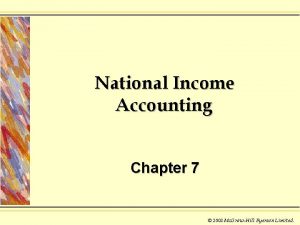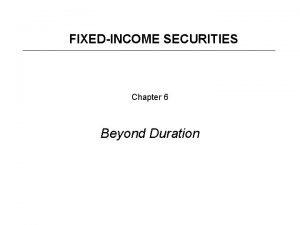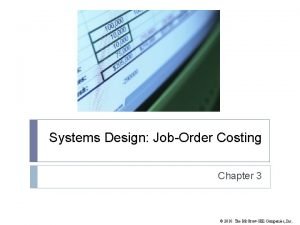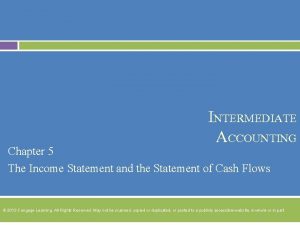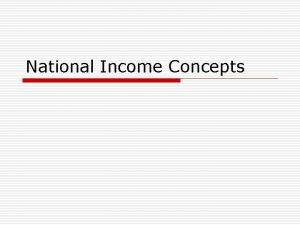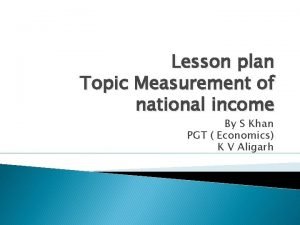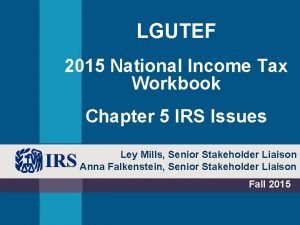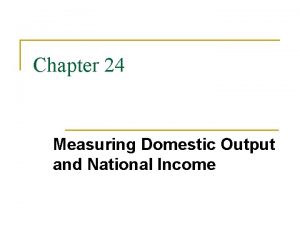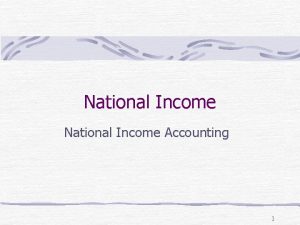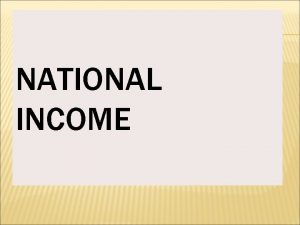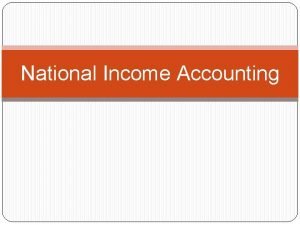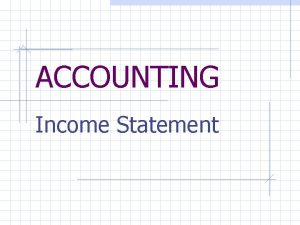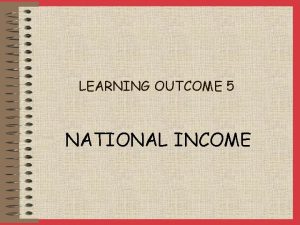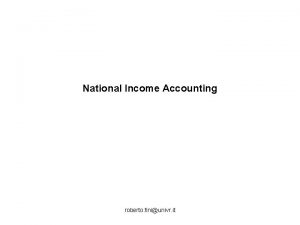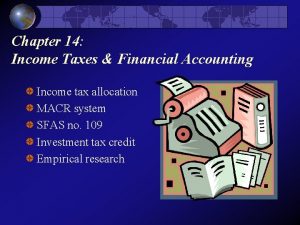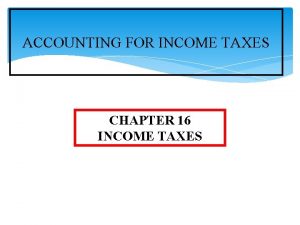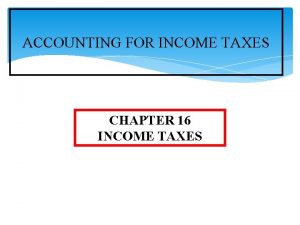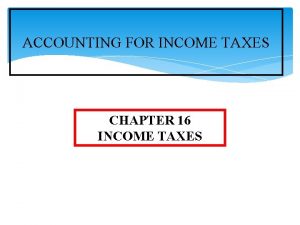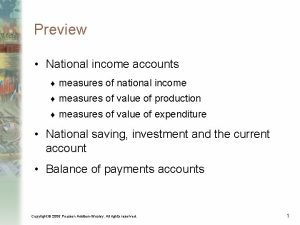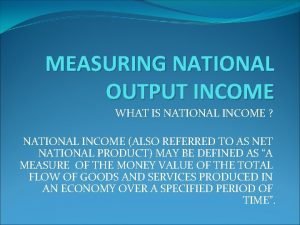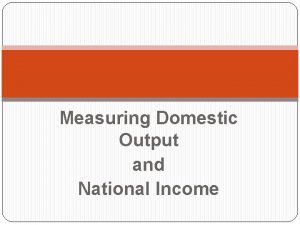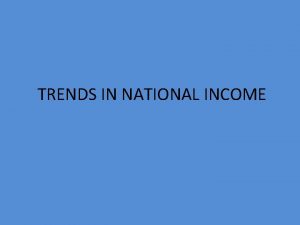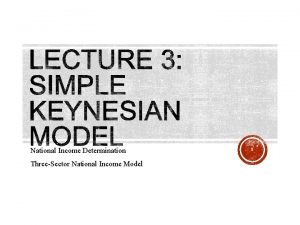Chapter 2 National Income Accounting Introduction Why do
























- Slides: 24

Chapter 2 National Income Accounting

Introduction • Why do we study the national income accounts? National income accounting provides structure for our macroeconomic theory models 1. • 2. • • Production/supply vs consumption/demand side of the economy Introduces statistics that characterize the economy Output typically measured as GDP = value of all final goods and services produced within a country over a particular period of time Output defined in two ways 1. 2. Production side: output = payments to workers in wages, capital in interest and dividends Demand side: output = purchases by different sectors of the economy output measured via demand production equal in equilibrium 2 -2

Production Side of the Economy • The production side of the economy transforms inputs (labor, capital) into output (GDP) • • • The relationship between inputs and outputs is defined by the production function Y = F(K, N) (1) • • • Inputs referred to as factors of production Payments to these factors are referred to as factor payments Y = output, N = labor, K = capital Output is then distributed as factor payments: wages (labor), rent (capital) and profit Sum of factor payments including profit = total output produced. 2 -3

GNP vs GDP We use the terms output and income interchangeably in macroeconomics, but are they really equivalent? And output can refer to GDP or GNP Factor payments include net income received from abroad These are included in GNP but not in GDP vs GNP • • 1% difference for the US 20% for Ireland (GDP > GNP) 17% for Switzerland (GNP > GDP) 2 -4

From GDP to National Income • There a few crucial distinctions between output and income: 1. Capital wears down over time Net domestic product = GDP – depreciation • • 2. NDP is the total value of production minus the value of the amount of capital used up in producing that output NDP is usually 89% of GDP Businesses pay indirect taxes (i. e. taxes on sales, property, and production) that must be subtracted from NDP before making factor payments National Income = NDP – indirect business taxes • • Indirect business taxes account for nearly 10% of NDP National income is roughly 80% of GDP 2 -5

Demand Side • Total demand for domestic output is made up of four components: 4. Consumption spending by households (C) Investment spending by firms (I) Government spending (G) Foreign demand for our net exports (NX) The fundamental national income accounting identity: 1. 2. 3. (3) 2 -6

Consumption • Consumption = purchases of goods and services by the household sector • • • [Insert Figure 2 -2 here] Includes spending on durables (e. g. cars), non-durables (e. g. food) and services (ex. education) Consumption is the primary component of demand Consumption as a share of GDP varies over time and by country • Figure 2 -2 compares consumption as a share of GDP for the U. S. to Japan 2 -7

Government • • Government purchases of goods and services include items such as national defense expenditures, road building by state and local governments, and salaries of government employees Government also makes transfer payments: payments made to people without their providing a current service in exchange • • • Ex. Social security, unemployment benefits Transfer payments are NOT included in GDP since not a part of current production Government expenditure = transfers + purchases 2 -8

Investment • • Gross Investment = additions to the physical stock of capital (i. e. building machinery, construction of factories, additions to firms inventories) Does not include investment in financial capital purchases of stocks and shares Household’s building up of inventories is considered consumption, although new home constructions is included in I, not in C Gross vs net: investment included in GDP is not corrected for depreciation • Net investment = Gross investment – Depreciation 2 -9

Net Exports • • Accounts for domestic purchases of foreign goods (imports) and foreign purchases of domestic goods (exports) NX = Exports – Imports NX can be positive, negative or zero • [Insert Fig. 2 -4 here] U. S. NX has been negative since the 1980’s trade deficit 2 -10

Some Identities: A Simple Economy • • • Assume national income equals GDP, and thus use terms income and output interchangeably (convenience) Begin with a simple economy: closed economy with no public sector output expressed as (4) Only two things can do with income: consume and save national income expressed as (5), where S is private savings Combine (4) and (5): (6) Rearrange (6): (7), or investment = savings In closed economy, new capital can only be built by postponing consumption saving 2 -11

Some Identities: Adding G and NX • • When we add the government and the foreign sector, the fundamental identity becomes (8) Disposable (after-tax) income: (9) • • • where TR = transfer payments and TA = taxes YD is split between C and S: (10) If rearrange (9) and substitute (8) for Y, then (11) • Substituting (10) into (11): (12) • Rearranging: (13) 2 -12

S, I, Government Budget, and Trade (13) G + TR is total government expenditure and TA is government income • • • Excess of savings over investment (S > I) in the private sector is equal to the government budget deficit plus the trade surplus Private sector can dispose of savings in three ways: 1. 2. 3. • Make loans to the government Lend to foreigners Lend to firms who use the funds for I When savings and investment are approximately equal, government deficit tends to lead to trade deficit 2 -13

Measuring Gross Domestic Product • GDP = the value of final goods and services currently produced within a country over a period of time • • • Only count final goods and services NO DOUBLE COUNTING • Ex. Would not include the full price of a car AND the tires bought by the manufacturer for the car tires = intermediate goods • To avoid double counting, calculation of GDP considers value added only Only count goods and services currently produced (in the time period being considered) & exclude transactions involving used goods • Ex. Include the construction of new homes in current GDP, but not the sale of existing homes (real-estate-agent fees are included as services!) Only count goods and services produced within a country, regardless of the ownership/nationality of the producing firm • Ex. Include the sale of a car produced by a Japanese car manufacturer located in the U. S. in U. S. GDP 2 -14

Problems of GDP Measurement • There are three major problems with measuring GDP: Omits non-market goods and services 1. • • No accounting for “bads” such as crime and pollution 2. • Ex. Crime and pollution are detrimental to society, but there is no subtraction from GDP to account for it No correction for quality improvements 3. • • Ex. Work of stay-at-home mothers and fathers not included in GDP Government services not always evaluated at market-clearing prices Ex. PC are cheaper at present than 20 yrs ago despite being much faster and more powerful Despite these drawbacks, GDP is still considered one of the best economic indicators for estimating growth in an economy 2 -15

Nominal vs. Real GDP • • • Output is included in GDP in dollars, not in physical units NGDP is the value of output in a given period measured in current dollars • NGDP in 2007 is the sum of the value of all outputs measured in 2007 dollars: • Changes in NGDP could be purely due to changes in prices if GDP is to be used as a measure of output, need to control for prices RGDP is the value of output in constant dollars scaled by a base -year price, so that any change in GDP is due to changes in production, not prices • If PB is the price in the base year for good i, RGDP in 2007 is: 2 -16

Inflation and Prices • • • Inflation, , is the rate of change of prices: where Pt is today’s price and Pt-1 is last period’s price Additionally, , or today’s price equals last year’s price, adjusted for inflation If > 0, prices are increasing over time inflation If < 0, prices are decreasing over time deflation How do we measure prices? • • For the macroeconomy, need a measure of overall prices = price index There are several price indexes, but most common are CPI, PPI, and the GDP deflator 2 -17

Price Indexes: GDP Deflator • GDP deflator is the ratio of NGDP in a given year to RGDP of that year • • • Since GDP deflator is based on a calculation involving all goods produced in the economy, it is a widely based price index that is frequently used to measure inflation Measures the change in prices between the base year and the current year Ex. If NGDP in 2006 is $6. 25 and RGDP in 2006 is $3. 50, then the GDP deflator for 2006 is $6. 25/$3. 50 = 1. 79 prices have increased by 79% since the base year 2 -18

Price Indexes: CPI measures the cost of buying a fixed basket of goods and services representative of the purchases of urban consumers • • • Measure of the cost of living for the average household Differs from GDP deflator in three ways: 1. 2. 3. CPI measures prices of a more limited basket of goods and services (only household goods and services) The bundle of goods in the consumer basket is fixed, while that of the GDP deflator is allowed to vary CPI includes prices of imports, while GDP deflator only considers the goods produced domestically 2 -19

Price Indexes: PPI • PPI measures the cost of buying a fixed basket of goods and services representative of a firm • • Captures the cost of production for a typical firm Market basket includes raw materials and semi-finished goods PPI is constructed from prices at an earlier stage of the distribution process than the CPI PPI signals changes to come in the CPI and is thus closely watched by policymakers Over long periods of time, the two measures yield similar values and trends for inflation 2 -20

Price Indexes: RPI • • • Measure used in the UK Just as CPI, it measures the cost of buying a fixed basket of goods and services But the basket is different • • RPI includes council tax and mortgage payments Policy importance: RPI traditionally used to index public pensions and in wage bargaining 2 -21

Unemployment • • The unemployment rate measures the fraction of the workforce that is out of work and looking for a job or expecting a recall from a layoff Important indicator of wellbeing of an economy Unemployment linked to the potential level of output for a given economy Unemployment differs from country to country different ‘natural’ unemployment rates [Insert figure 2 -8 here] 2 -22

Interest Rates and Real Interest Rates • Interest rate = rate of payment on a loan or other investment, over and above the principle repayment, in terms of an annual percentage • • Cost of borrowing money OR benefit of lending money Nominal interest rate = return on an investment in current dollars Real interest rate = return on an investment, adjusted for inflation If R is the nominal rate, and r is the real rate, then we can define the nominal rate as: R = r + 2 -23

Exchange Rate • • Most countries have their own currency in which prices are quoted Exchange rate = the price of a foreign currency • • • Floating exchange rate price of a currency is determined by supply and demand Fixed exchange rate price of a currency is fixed • • Ex. £ 1 is worth U. S. $ 1. 58 Ex. A Bermuda dollar is always worth one U. S. dollar Managed float exchange rate is not fixed but regulated by frequent interventions in the currency markets. 2 -24
 Journal entry for revaluation of assets
Journal entry for revaluation of assets Loss contingency journal entry
Loss contingency journal entry Calculate real gdp per capita
Calculate real gdp per capita Ano ang pormula sa pagsukat sa pamamaraan ng gastusin
Ano ang pormula sa pagsukat sa pamamaraan ng gastusin Gnp vs gdp
Gnp vs gdp Pictures
Pictures Income tax expense
Income tax expense Total income
Total income Financial accounting chapter 1
Financial accounting chapter 1 Dont ask why why why
Dont ask why why why Income statement in financial accounting
Income statement in financial accounting Income accounting u of u
Income accounting u of u Fixed income accounting
Fixed income accounting Cost accounting income statement
Cost accounting income statement Multi step income statement
Multi step income statement Fas 109 and fin 48
Fas 109 and fin 48 National income concepts
National income concepts The national income and product accounts
The national income and product accounts Lesson plan on national income
Lesson plan on national income National income formula
National income formula Lgutef
Lgutef Measuring domestic output and national income
Measuring domestic output and national income Linear algebra
Linear algebra Final expenditure approach
Final expenditure approach What is national income
What is national income











